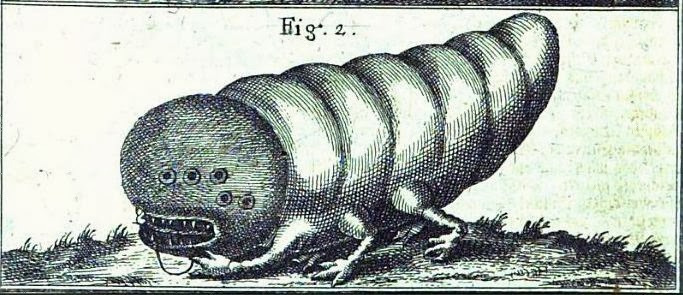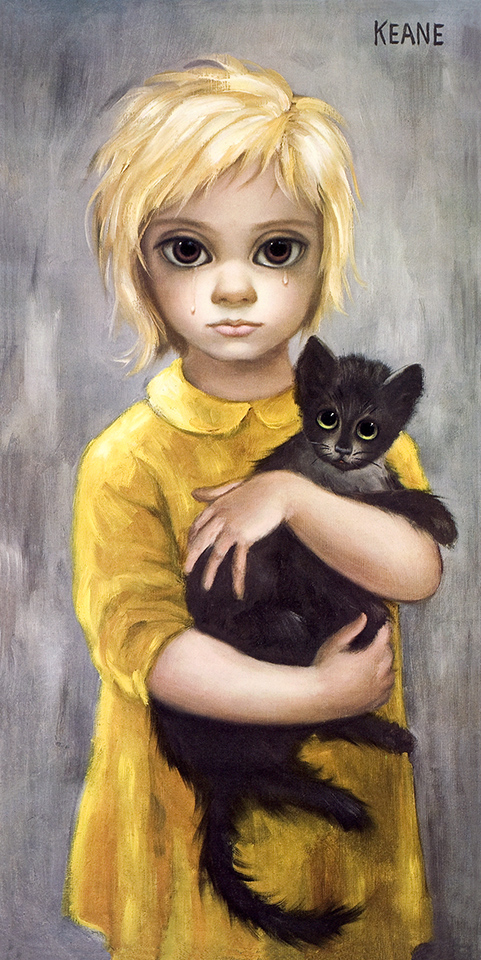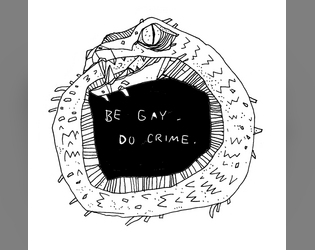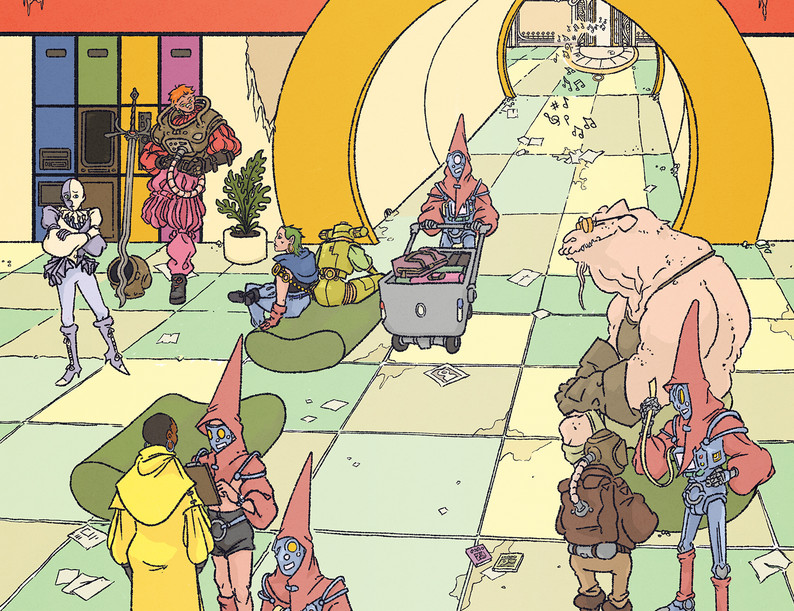SageDaMage is an indie tabletop creator who I first properly got to know from the
Funnel Jam which Sage hosted. I had intended to create a
Superhero Funnel for the jam inspired by My Hero Academia, which later became my
Superpowers 2.0 post. Unfortunately, I ended up overengineering the game a bit and it just didn't quite come together the way I would have hoped in time for the deadline, and I've always felt a little guilty about that.
However, since then Sage and I have played in several games together. He playtested the Superhero Funnel and also an extremely rough draft version of MRD2. I have also played in several games of his, including an Into the Odd one-shot based on World of Horror, the Into the Odd adventure The Iron Coral, and a condensed version of Silent Titans using MRD as the system (see my PC for that game
here).
We also touch on some fairly heavy topics, a little bit at the beginning and especially at the end. I really appreciate what Sage had to say, so I hope others find this interview as moving and inspirational as I did.
This interview occurred before the official announcement or launch, but Sage is currently crowdfunding
Discordantopia on itch!
Max: Your games trend towards being rules-light and mechanically distinct, even to the extent that they build off of other systems. Can you discuss your history with TTRPGs and your approach to game design?
Sage: My history with TTRPGs is fairly standard for people in my niche, I'd say. In 2014, my dad ran the 5e starter set. Aside from the fact that I nearly died IC for charging into battle as a wizard, I was absolutely enamored by being able to tell stories collaboratively. Specifically, that my dad could exert such control over the story and what we saw and interacted with. In 2014 I was a little too young, but I got back into it a few years later with Play-By-Post. I've been doing PBP for at least 5 years now. That's the basic history, although I can certainly go deeper into how I came to where I am today, at least in terms of game philosophy.
I started practicing my modern approach to game design well before I really knew how to run what I was writing, funnily enough. For example, my first two systems,
Indexx and
Anime Messerspiel, I couldn't run it if you wanted me to, at the time. I just knew that there was an audience for that sorta thing, was inspired by the systems I saw, and pressed publish!
My gateway into learning more about how to actually run the games I wrote as well as designing more of them came through the FKR Collective, although the NSR discord was an important role too, although more for feedback than anything else. In about a year, I went from running structured games fairly tightly to, now, being able to run anything the way I like, including running no system at all!
Anyway, my approach to game design is more out of necessity than it is out of (initially, moreso) wanting to design small games. I have ADD it makes me constantly all over the place, bouncing from idea to idea. Most of what you see on my itch was completed in a short period of time, where I just kinda had a burst of motivation and finished it. I ALWAYS have grand ideas for RPGs. However, it's hard to get the attention to finish them. As well, although more recently, I've been preferring the lack of a grand RPG.
Max: Refining those grand ideas into something manageable is difficult with or without ADD, although I can imagine that only makes it harder. I did not realize you had ADD, but with that in addition to you being so young, if you don't mind me saying, it's impressive to me how engaged you are with TTRPGs and how much you've already created. So as far as the grand ideas go, take your time!
Sage: Thank you! I'm also autistic (might as well throw the big diagnosis out there), a symptom of which is hyper-fixation. Combined, though, with ADD, it's more of a scattered hyper-fixaton. And, I am taking my time! I have the luxury of it, and I certainly use it. I've been working on some big stuff, that I've surprisingly stuck to.
Max: Oh ya? Anything you would feel comfortable talking about?
Sage: The longest one so far is Spectrum, my therapeutic RPG, which I'm working on with an actual therapist. It was initially more for her than me, but as I've come to appreciate both wholesome RPGs as well as RPGs that deal with sensitive topics, it's kinda become my baby.
Max: Oh wow, that's super interesting and also a really admirable thing to put out in the world. I used to do research in psychology and neuroscience, not therapy or clinical work, but it's still something I deeply appreciate. Can you elaborate on the kinds of psychological concepts that will be explored in the game?
Sage: I want to make basically "playkits" for different types of therapy, which will guide the therapist (who probably hasn't touched an RPG before) to tailor the game to those themes. The therapist I'm making it for generally explores social anxiety and that sorta thing with her kids, but also does more generalized therapy, so the RPG medium ticks the first box, but then the RPG itself needs to be tailored to different players/groups. In the FKR fashion, it will be procedure heavy with minimal rules. 90-100% of them will be GM-facing. Undecided if there should be a way for the players to gain agency through a mechanic or not.
Max: Procedure-heavy is a good term for what I was referring to before. I'm less well read on the FKR scene so it didn't immediately come to mind but I think I've heard that phrase used before in the context of FKR.
You had mentioned starting with 5e and then moving in the direction of FKR, but what is it about the procedure-heavy, rules-light approach that appeals to you especially?
Sage: Part of what I don't like about 5e is that most of the players have expectations that need to be met on how the game is run. In order to solve that, I moved away from 5e. Then, I had players thinking quite mechanically, wanting to push mechanisms to progress in the story (I was running Dungeon World and other PbtA stuff for a bit). I had a problem with that, so I moved to the OSR. I felt that the OSR was a bit too into itself for my tastes, so moved to the NSR and Into the Odd. From there, I kept exploring the boundaries of my limits on what was too little or too much. Turns out, it was all attitude. I like the FKR because it's style can, theoretically, be applied to any game. To really enjoy myself, I just needed to sigh and let go the importance of rules.
Max: I appreciate the eclecticism for sure. Again, being less well-versed in FKR (if it had been a thing a couple of years earlier I probably would know more about it but I sort of missed the window...) I may lack some of the language or I may ask some rudimentary questions, but in any case, are there any specific kinds of procedures, or approaches to designing procedures, that have influenced you?
Sage: Out of everything, the one thing that stuck with me throughout my entire GMing career was a page from Worlds in Peril, a superhero game I played in, about narrative scale.
Basically, it talks about thinking about the scale at which you are having a conflict. Are you fighting mooks, or the main villain? If mooks, conditions (a mechanic in the game) applied should be lower in danger. If a villain, conditions applied would be a lot higher in danger.
Despite being mechanically bound, the advice was quite great for thinking about a combat narratively and how results could be reached.
A lot of it was "use common sense," which, up to that point, I'd never really heard before in an RPG. Shouldn't you rely on the mechanics to determine that stuff? I remember thinking to myself. Turns out, no. "Use common sense" is my biggest "procedure" when I GM, now.
When I talk about procedure, honestly, most of it is so ingrained in my mind from practice, that it's hard to put to words. Muscle memory, if you will. Also part of why Spectrum has taken a long time. I'm not used to putting the procedure I commonly employ to words.
Max: Designing on a larger scale like that is definitely a different beast from just playing or running games, you start to realize all the holes in your understanding, or how the writing and organization of a game like that requires a whole separate skillset on top of everything else.
It's funny you say that about Worlds in Peril, while I haven't played it, I actually had a similar experience with Mutants & Masterminds- it was also one of the first games to make me realize how "common sense" and narrative construction can go into TTRPGs and it's not all just the typical D&D stuff.
So in addition to the kinds of systems and procedures, what about narrative, genre and worldbuilding? You've discussed Worlds in Peril and you have a superhero game of your own. You've run a World of Horror-inspired Into the Odd one-shot which I was a player in, and several of the games on your itch page are inspired by anime, Japanese videogames, or Japanese culture. From a worldbuilding or narrative perspective, would you consider these to be among your primary influences? What else might you consider to be primary influences?
Sage: I would, I really love epic moments in anime, and doing that collaboratively at a table just amplifies that love.
Speaking of my dad again, after running some 5e, he decided to try out Lamentations of the Flame Princess. This was while I was still futzing around with 5e not understanding why the square doesn't fit in the circle. Over like 3 years now, he's created an amazing acid fantasy campaign with his friends, and it's always endlessly inspiring to me.
Specifically, outside of the genre itself, the idea that the story becomes more and more grand over time. After 3 years, the players have done a lot to shake the city they've been playing in for the majority of the time. They might even go on to save the world from galaxy-hopping snake people that help strange mythical demons hatch at the core of the world to then consume them!
I've had a peek of this a bit later than his game, through a 3-year Play-By-Post game in the Pokemon universe. It used to use Pokemon Tabletop United, and now uses my own
Pokemon Zero.
Max: It's really cool that this is a passion you get to share with your dad. So he's the one who got you into TTRPGs, but is it because of his interest that you became passionate, or the other way around?
Sage: Yeah, he did get me into it, at least 5e. But then, before doing the Lamentations game, I was really passionate about RPGs, and inspired him to start the Lamentations game, thus going on to inspire me once more.
At some point down the line when I'm more confident in layout or can pay a layout artist, I want to make a system-neutral zine with my dad making the city he's been running into a thing other people can use.
Made a little layout plan, but haven't gotten too much further. Awhile ago, our goal was this ZineQuest to have something up, but that's far from happening now LOL!
Max: That's too bad that it may take a while longer, but that would also be a nice thing to be able to do!
Sage: Definitely!
Max: So we've talked about game design and procedures, worldbuilding, and even zines. What about adventure or campaign design? I know this is a thing you and I have discussed privately before, but I'm wondering if you've since thought more about it at all or changed how you think about it.
Sage: Adventures are tough for me, but I'm trying! I want to make a Liminal Horror mystery (again inspired by World of Horror), and finally finish my Mausritter adventure. Exciting news, recently; I'm going to have a little teaser of the adventure in ManaRampMatt's Bernpyle: YEAR ONE! It'll be in the hands of a lot of people, including myself, which is quite exciting! Something I want to do with future adventures (and the mystery I'm making) is make them more like DW Dungeon Starters than a rigid story. Asking questions to players, making the GM come up with explanations on the fly, that kinda thing. That's not really easier, but it does excite me more, which I guess makes it easier in the end.
Max: Motivation is a major factor! By Liminal Horror are you referring to a particular system (it sounds vaguely familiar), or do you mean that as a genre? And I have literally no idea what you mean by ManaRampMatt's Bernpyle: YEAR ONE, if you wouldn't mind explaining for me...
Sage: Liminal Horror is what I used in that World of Horror-inspired ItO one-shot 😉
Bernpyle is a series of fan zines for Mausritter by Matt, who is making a compendium of them from his first year doing so, that recently funded on kickstarter.
Max: Ooh that's why it sounded familiar! Ah ok, ya I know of Mausritter but am not especially familiar, good to know.
I see on various discord servers, you seem to run more games than practically anyone else I know. Often it seems like the people who are into game design, myself included, spend more time talking about games, blogging, reading, etc., than actually playing them! How do you balance engagement between these different aspects of TTRPGs?
Sage: Well, for one, I've gotten very good at running PBP near-prepless. I only do as much prep as I want/have time to do. So, really, I only need as much time as it takes to write a post. And my PBP games aren't super fast, either, which helps me having many of them.
I generally do PBP earlier and/or later in the day, when I have less energy, and devote my actual writing and theorizing to the middle when I have the most energy and my brain's working. For voice games, well, I haven't been doing a ton of them recently, mostly one-shot stuff since the campaigns I try to do with randos constantly fizzle out and they take more work for me.
Max: It can be really hard to get a campaign off the ground with a new group of randos, I find that I have to cycle through a few people before something actually sticks.
I used to do some completely free-form PBP stuff when I was much younger, but have never done PBP within the TTRPG scene like what you do. How would you describe the differences between running or playing in PBP games vs. real-time games?
Sage: The main pro of PBP is that you can actually think of responses instead of having to do something rushed. However, due to everyone thinking of responses, the pace is definitely a lot slower or more just "throughout the day." The main drawback is similar. Just having conversations surrounding the game is hard. Generally, in PBP, you just think to yourself and do your action. Unlike voice or IRL games, there's very little discussion happening about what to do. Someone just does it. This can lead to some slogs where no one knows what to do but doesn't talk about it. Most of the time it's fine, it's just quite different in that way.
Max: There's something to be said for that for sure, real-time games can be really demanding and exhausting, but I can also imagine the drawbacks of PBP that you're referring to.
We've covered a lot of ground, but is there anything else you'd like to talk about, or like to say?
Sage: I'd like to say a couple things to the readers real quick, while I have some eyes on the interview. Feel free to also discuss it yourself, Max.
Instead of doing boring self-promotion (which I'm sure Max has done for me anyway), I want to instill two things to readers of this interview. I'll start with the one that's outside of the indie TTRPG sphere. My mom has Dercum's Disease. I implore you to research it, I won't go into it too much, but I will say that it is a chronic, incurable disease which causes immense pain and is an autoimmune disorder. An important detail is that it is invisible. While my mom is permanently disabled and near-handicapped, no one would really know looking at her. The literal only way to tell is to feel her skin and find the fatty tumors in her lymphatic system. I mention this because, even as someone that lives around someone with an invisible disease, it is very hard to give them the sympathy they deserve because there's no visual cue to do so. It is a problem that is near and dear to my heart, and this opportunity to platform a bit is one I want to take helping. Even if 1 person has been reached by this, that's one more person than I wouldn't have reached had I not wrote this. To get on something happier, there's one other thing I wish to mention: how amazing the TTRPG community is. We are a part of an emerging medium that could revolutionize entertainment. I truly feel that. I just want you, the reader, to know that you're lucky to be a part of this community at this time. After the slump of 4e, within the massive spike of popularity from 5e. It allows us to leave a unique impact on the hobby as a whole. You just need to take the steps to do so. And many people are! In fact, it is awe-inspiring to me how reachable these "indie titans" are. While definitely not titans outside the sphere, never forget that your TTRPG hero is a Discord/Twitter DM away. It's very humanizing, to me, that people I basically idolize for their design are a click away. Anyway, that's enough of me giving my Valuable Life Lessons(TM).
Max: Wow, you really caught me off guard with this I have to say. I appreciate you saying all of this. Like what you were saying even with ADD and autism as well, there are a lot of ways people can be struggling or suffering right in front of us, without it being obvious. I'm sorry that that's a thing you've had to deal with in multiple regards. It's all the more impressive to me now, how much you've already accomplished for someone so young, and for having such a positive attitude, and having this kind of perspective about the importance of a healthy community. I hope others appreciate what you have to say here as well, this was really wonderful. In practically every one of these interviews I do, at some point I say, "this is why I do these interviews", but I don't know if anything can top this, you've well deservedly taken the crown!
Sage: Thank you! I appreciate the opportunity. Being nice pays off so much in so many ways, it's a wonder to me sometimes why you'd be any other way! I mean, there are a lot of reasons, and I've been there myself, but moreso just... choosing to be mean. People don't choose to have an anger issue or something, but they can choose to do something about it.
Max: I definitely agree with that. Without putting more pressure on you, I really look forward to one day seeing Spectrum. At the end of this interview, I can see how you've really got a good perspective on what TTRPGs can do and how they can be used to help people. Thanks for your doing this interview!
Sage: Not a problem. Lots of fun.
